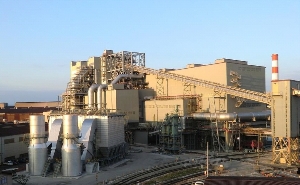Kobe Steel, Ltd.’s new hot-metal treatment plant has gone into operation in April at its Kakogawa Works in western Japan. The company previously announced that it would construct the facility to improve the production system at Kakogawa to expand sales of high-end “Only One” steel products and increase its cost competitiveness.
 New hot-metal treatment plant (Kakogawa Works)
New hot-metal treatment plant (Kakogawa Works)
Hot-metal treatment is a process to remove impurities—sulfur and phosphorus—in the molten iron. Kobe Steel’s high-end steel products, such as special steel wire rod and bar, automotive high-strength steel sheet, and steel plate for the energy sector, require a high degree of cleanliness. To produce these steels, hot-metal treatment is an essential process.
The new hot-metal treatment plant has two Kanbara reactors for desulfurization and one dephosphorization furnace. The new plant, together with existing equipment, enable nearly all of the molten iron to undergo hot-metal treatment and will enable Kobe Steel to further increase the production capacity of high-end Only One products.
The new hot-metal treatment plant increases the reaction efficiency during desulfurization and dephosphorization, thereby reducing the consumption of auxiliary materials for refining and improving yield. The new facility will enable Kakogawa Works to save approximately 6 billion yen annually.
Striving to strengthen the competitiveness of its steelworks, Kobe Steel is working to raise its presence in the market and increase its profitability.
Details of Kakogawa Works’ new hot-metal treatment plant
- Total investment: About 30 billion yen
- Start-up: April 2014
- Main equipment: Two Kanbara reactors, one dephosphorization furnace
The Kanbara reactor uses a stirring method to desulfurize molten iron. An impeller stirs the molten iron and the agitation removes the sulfur.